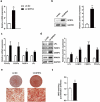SPRY4 promotes adipogenic differentiation of human mesenchymal stem cells through the MEK-ERK1/2 signaling pathway
- PMID: 36082406
- PMCID: PMC9481072
- DOI: 10.1080/21623945.2022.2123097
SPRY4 promotes adipogenic differentiation of human mesenchymal stem cells through the MEK-ERK1/2 signaling pathway
Abstract
Obesity is a chronic metabolic disorder characterized by the accumulation of excess fat in the body. Preventing and controlling obesity by inhibiting the adipogenic differentiation of mesenchymal stem cells (MSCs) and thereby avoiding the increase of white adipose tissue is safe and effective. Recent studies have demonstrated that Sprouty proteins (SPRYs) are involved in cell differentiation and related diseases. However, the role and mechanism of SPRY4 in MSC adipogenic differentiation remain to be explored. Here, we found that SPRY4 positively correlates with the adipogenic differentiation of human adipose-derived MSCs (hAMSCs). Via gain- and loss-of-function experiments, we demonstrated that SPRY4 promotes hAMSC adipogenesis both in vitro and in vivo. Mechanistically, SPRY4 functioned by activating the MEK-ERK1/2 pathway. Our findings provide new insights into a critical role for SPRY4 as a regulator of adipogenic differentiation, which may illuminate the underlying mechanisms of obesity and suggest the potential of SPRY4 as a novel treatment option.
Keywords: ERK1/2; SPRY4; adipogenic differentiation; hAMSCs; obesity.
Conflict of interest statement
No potential conflict of interest was reported by the author(s).
Figures






Similar articles
-
Suppression of SPRY4 Promotes Osteogenic Differentiation and Bone Formation of Mesenchymal Stem Cell.Tissue Eng Part A. 2019 Dec;25(23-24):1646-1657. doi: 10.1089/ten.TEA.2019.0056. Epub 2019 Aug 9. Tissue Eng Part A. 2019. PMID: 30982407
-
A novel Sprouty4-ERK1/2-Wnt/β-catenin regulatory loop in marrow stromal progenitor cells controls osteogenic and adipogenic differentiation.Metabolism. 2020 Apr;105:154189. doi: 10.1016/j.metabol.2020.154189. Epub 2020 Feb 24. Metabolism. 2020. PMID: 32105664
-
Obesity-Associated MiR-342-3p Promotes Adipogenesis of Mesenchymal Stem Cells by Suppressing CtBP2 and Releasing C/EBPα from CtBP2 Binding.Cell Physiol Biochem. 2015;35(6):2285-98. doi: 10.1159/000374032. Epub 2015 Apr 13. Cell Physiol Biochem. 2015. PMID: 25895816
-
The Role of Pref-1 during Adipogenic Differentiation: An Overview of Suggested Mechanisms.Int J Mol Sci. 2020 Jun 9;21(11):4104. doi: 10.3390/ijms21114104. Int J Mol Sci. 2020. PMID: 32526833 Free PMC article. Review.
-
[Regulation of adipose progenitors and fibro-adipogenic progenitors through primary cilia].Nihon Yakurigaku Zasshi. 2024 Jul 1;159(4):188-191. doi: 10.1254/fpj.23108. Epub 2024 Apr 26. Nihon Yakurigaku Zasshi. 2024. PMID: 38684399 Review. Japanese.
Cited by
-
Effects of miR-29c on proliferation and adipogenic differentiation of porcine bone marrow mesenchymal stromal cells.Adipocyte. 2024 Dec;13(1):2365211. doi: 10.1080/21623945.2024.2365211. Epub 2024 Jun 10. Adipocyte. 2024. PMID: 38858810 Free PMC article.
-
A novel human specific lncRNA MEK6-AS1 regulates adipogenesis and fatty acid biosynthesis by stabilizing MEK6 mRNA.J Biomed Sci. 2025 Jan 8;32(1):6. doi: 10.1186/s12929-024-01098-3. J Biomed Sci. 2025. PMID: 39773638 Free PMC article.
-
Multiple endocrine defects in adult-onset Sprouty1/2/4 triple knockout mice.Sci Rep. 2024 Aug 22;14(1):19479. doi: 10.1038/s41598-024-70529-w. Sci Rep. 2024. PMID: 39174793 Free PMC article.
References
Publication types
MeSH terms
Substances
LinkOut - more resources
Full Text Sources
Other Literature Sources
Molecular Biology Databases
Miscellaneous
